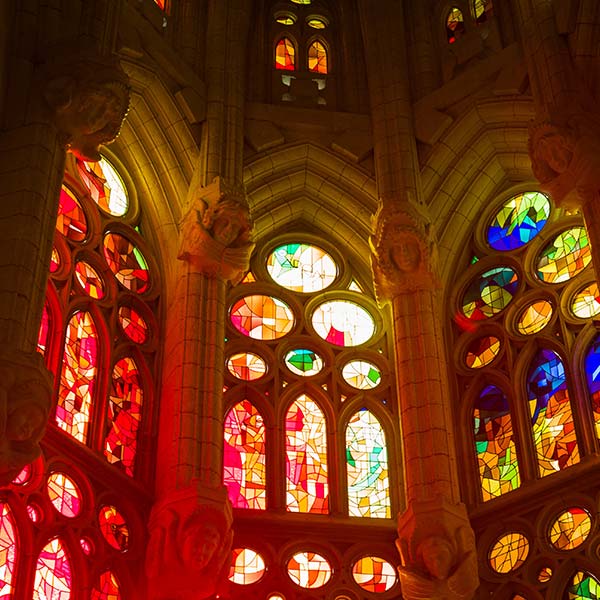Subtotal: $
Checkout
This article was originally published on November 27, 2013.
Take the path that leads inward through the days of Advent. Set aside for yourself, if it is possible, time to breathe in; time to stop feeling that you’re on the run or under stress. Allow something to happen inside you. Turn your thoughts and hopes to the things that count.
I am standing, in my mind’s eye, at the gates of a noble old church, inviting you to celebrate the feast of hope we call Advent. From time immemorial, the essence of this festive season has been connected with the thought that somewhere, somehow, there are doors that need to be opened in our lives. Doorways to freedom – to a fuller life – to salvation.
At Advent we sing, “Lift up your heads, ye mighty gates!” – and with these words we affirm that none of us lives in a completely sealed space. We each have in us a door that can be opened, a door through which we can step into a new and different room; or a door through which something can come to us – for instance, an awareness of a world greater than our own.

Photograph by Mitya Ivanov
And we can actually walk through these doors, knowing that on the other side there is something waiting for us; something about to arrive and enter our lives. Advent. The word implies that something is approaching us.
As Christians we do not believe in walls, but that life lies open before us; that the gate can always be unbarred; that there is no final abandonment or desertion. We do not believe that it can ever be “too late.” We believe that the world is full of doors that can be opened. Between us and others. Between the people around us. Between today and tomorrow. Our own inner person can be unlocked too: even within our own selves, there are doors that need to be opened.
There, for me, lies the meaning of the grand old portals of the church. If we open them and enter, we can unlock ourselves, too, and so await whatever is coming to free us and make us whole.
Once we enter the gates of Advent, we enter a season of silence. Of course, that is hardly true today. In earlier times people went through it step by step, as the days grew shorter and the nights longer, until, in the midst of the darkness, they received the Mystery.
Today this experience has been lost for many, if not most. It has been overwhelmed by lights, drowned out by noise, overrun with emptiness, busyness, restlessness. The feast it leads up to, which was once a real source of strength, has become a time of inner and outer exhaustion.
Christmas pictures tend to show the Child in a cozy manger, replete with his beautiful mother and a reliable father-figure poised in a dreamlike stall. Yet many of us live in a world in which our anxieties cannot be stilled with a romantic tale. Inwardly homeless, we are driven once a year to the edge of Christ’s own feast to find only the sentiments and memories of childhood. But that is not the meaning of the Christmas story.
Translated from Jörg Zink, Türen zum Fest. Verlag am Eschbach, 2010. Used with permission.
Doors to the Feast – Part I
Doors to the Feast – Part II
Doors to the Feast – Part III
Doors to the Feast – Part IV
Jörg Zink (1922 - 2016) was a German Protestant theologian and pastor. He survived his plane being shot down by British forces, one of three from the squadron of 400 men, and in 1945 was taken prisoner by the US. After his release he studied at the University of Tübingen. He was a voice for the peace and ecological movement.
Already a subscriber? Sign in
Try 3 months of unlimited access. Start your FREE TRIAL today. Cancel anytime.






June De Wit
Love so much!
Nicole Solomon
All four parts of this are not only the call for Advent and Christmas, but of this New Year and where we want to go with it. When he writes, "It is important not to defend ourselves from the world, or against other people. They too belong to God. We need not fear or hate anyone," it is striking to me how we build up walls that allow us to separate ourselves from others inwardly. We think we are different from "those people" because "we do this or that" and find a reason to separate ourselves from others justifiably in the name of God. I think what this New Year calls us towards is unity. We need to unite with all men in trust that God can speak through even the least of His, and yes, we are all His. Our family plans to read this together for our New Years tonight as a reminder that our walk begins in Bethlehem and ends on a cross, and everything in between those two points belong to God, including those we meet on our path. It is a striking word here to us as Christians that we must urgently grasp so we can be ready to be the real open vessels that Jesus needs us to be in this coming year for God's Kingdom. These are my deepest thoughts on all of this and forgive me if I overstepped in anything I said here. I am very grateful to have read this.